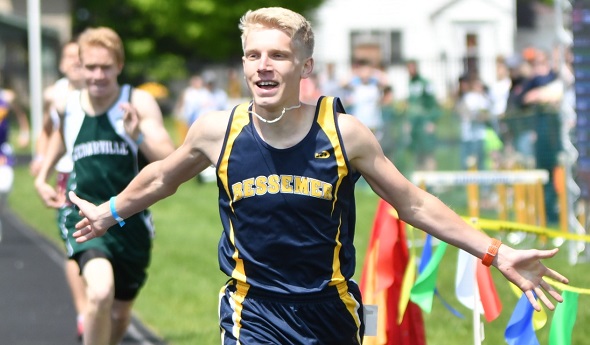
Record-Setter Leads Bessemer Repeat
June 1, 2019
By Adam Niemi
Special for Second Half
KINGSFORD - Bessemer earned its name.
How could the aptly named Speedboys, whose logo is a winged shoe, not win a track & field meet?
They did just that Saturday at Kingsford High School's Flivver Field.
Bessemer's 136 points were enough to comfortably win its second straight UP Division 3 Finals after taking second place in 2017.
Lake Linden-Hubbell was second this time with 67 points, edging Brimley by a point for the runner-up spot.
"They've done excellent. We have done well for the past few years," Bessemer coach Tracy Rowe said. "We took first place last year, lost by four points the year before. They're a really dedicated group of boys.
“A lot of it starts with these kids in cross country, basketball, football. They're just really good athletes. It's just not one person. You can have one student or one athlete and you're not going to win. Of the 13 who made it, all of them except two or three were doing four events. That's phenomenal. They're multi-talented."
Rapid River took fourth with 60 points, and Powers North Central was fifth with 42.
Bessemer's Uriah Aili set Division 3 UP Finals records in the 800, 1,600 and 3,200.
Aili's 800 was timed at 1:59.93, beating his own record (2:01.08) from 2018.
He set the 1,600 record with a time of 4:28.68, five seconds faster than Cedarville's Thomas Bohn ran in setting the previous record in 2018.
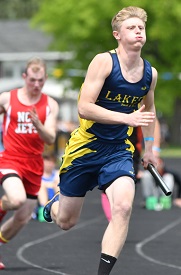 Aili's 3,200 time was 10:08.51. Wakefield's Ryan Holm had set the record in 2001 at 10:10.06. Aili’s 3,200 time may have been even better had he not run the 800 shortly beforehand.
Aili's 3,200 time was 10:08.51. Wakefield's Ryan Holm had set the record in 2001 at 10:10.06. Aili’s 3,200 time may have been even better had he not run the 800 shortly beforehand.
"The 800 took some of the wind out of me," Aili said. "This is my last day of high school running. It's definitely a good way to end. This means the world to me. We have such a small school, and the younger kids look up to me. Now they know what's possible."
Jamie Jett gave the Speedboys wins in the 110 and 300 hurdles. He also took fourth in the 200 and fifth in long jump.
Bessemer won the 1,600 and 3,200 relays.
"Have fun. We told them have fun, do your best," Rowe said. "If you do your best, things will fall where they should fall. You can kind of look at where the seeds are. We've had years where everything has gone wrong. A few years ago a person trips on the hurdles, and someone else sprains an ankle the week of. Keep healthy, do your best, work as a team and support each other."
Lake Linden-Hubbell won the 200 and 400 relays. Stephenson's Montell Glover won the 100 dash. Powers North Central's Leo Gorzinski won the 200. Ontonagon's Noah Lukkari won the 400 with a 52.56.
Lake Linden-Hubbell's Cole Gregorie won the high jump at 6 feet. He also won the long jump at 19 feet, 9 inches.
Bessemer's Zach Baross won the pole vault, and teammate Tyler Busch won the shot put at 47-5.50. Rapid River's Gunner Larson won the discus at 141-4.
PHOTOS: (Top) Bessemer's Uriah Aili wins the 800 on Saturday, one of three individual victories for the Speedboys standout. (Middle) Lake Linden-Hubbell's Kellen Klein carries the baton for one of his team's two relay winners. (Photos by Cara Kamps.)
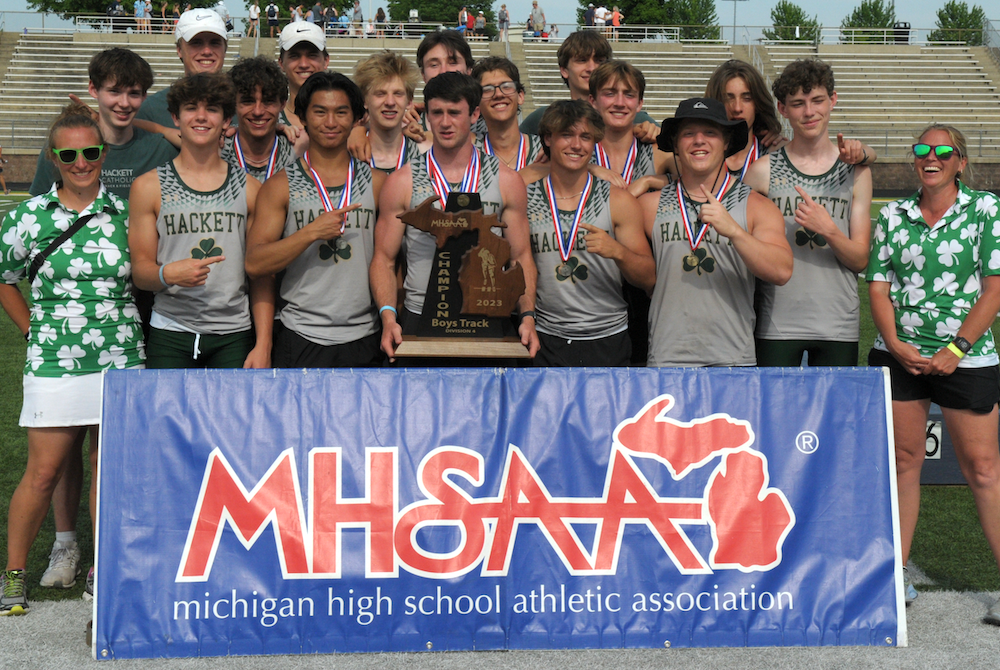
Thrower Claims Lone Individual Title to Lead Hackett to Team 3-Peat
By
Tom Lang
Special for MHSAA.com
June 3, 2023
Kalamazoo Hackett Catholic Prep just keeps winning and winning.
This time the Irish took home their fourth title in the last five Lower Peninsula Division 4 Track & Field Finals, on Saturday at Hudsonville.
Hackett’s only individual title was taken by discus winner Nathan Buchmann, a senior, who was fine knowing he was the shortest in stature among all the sizable competitors.
“In the offseason after football I worked out every day, working towards this goal,” he said after getting his medal. “I would say this takes 80 percent technique and 20 percent strength to throw the discus. So, length can help but if you have good technique and are really strong, that will play into it.
“I think we are very balanced throughout the meet today,” he said about teammates that scored points in finishes other than first place. “We have 13 guys here today, and we have people in a lot of the races. But I do not run; I have too short of legs to be a fast runner,” he said with a chuckle.
Buchmann had to work through a hip injury to compete this spring.
“I think the setbacks are what make you strong,” he said. “You can either give up through the setbacks or push forward and become better.”
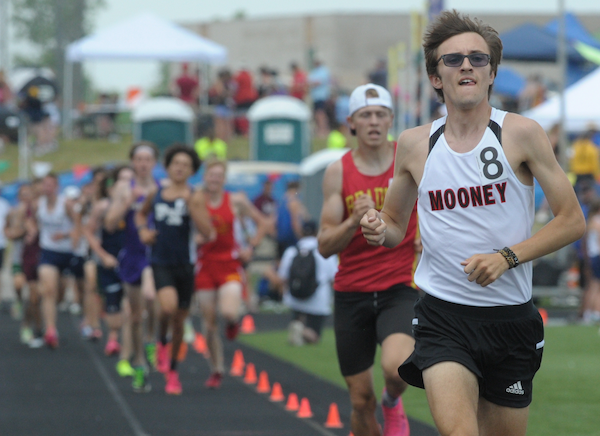 Coach Charissa Dean agreed.
Coach Charissa Dean agreed.
“The kids have big hearts,” she said after all the points were totaled and the Irish were on top once again, with 53. “They worked hard. They had a lot of potential when we started the season. And we had a lot of drive to put in the work, and we are happy the results came out the way they did.”
Reading was runner-up at 47 points, followed by Wyoming Potter’s House Christian with 42, then Fowler and Flint Beecher each with 37 points.
Senior Lezawe “Moses” Osterink, of Potter’s House Christian, placed second in 1,600 but took the 3,200 title as defending champ of both. He dominated the latter by lapping the field with a final lap kick that resembled more of a superhero speedster.
“Nobody really took it out that hard at the start,” he said. “There was a freshman (Marek Butkiewicz of Hackett) that tried to get the pace going quick, but me and Dakota (Dykhuis of Montabella) just kind of sat back and gradually pulled him through.
“We took it gradually, and I was just relying that I could kick.”
Kick did he ever. The trio were neck and neck the majority of the race in a grouping ahead of the pack.
“With 400 to go I just tried to go all out,” Osterink said. “I had a lot more left than I thought and I was pleased with the win. Not really the time, but that doesn’t matter, especially this hot out.”
The overall meet was in the low 90s/high 80s heat and searing sun all day. So, race officials allowed the unique opportunity for coaches to spray the runners with water and give them water bottles.
“It was very weird because I’ve never taken water to drink while I’m running, so I didn’t know how that would feel,” Osterink said. “And they were spraying us and hitting us in the face. It was kind of fun.”
Junior Tyler Lenn of Marine City Cardinal Mooney defeated Osterink at his own game in the 1,600.
“I’m feeling great,” Lenn said after grabbing the medal. “I said to a newspaper after one of my races (during the season) I was right where I wanted to be. This has been a long rebuilding process for me since an injury back in the fall, and I set a pretty high goal the day the injury happened. I was telling myself I needed to fulfill what I said I would do at the beginning of last cross country season. And that is what I did today.”
Lenn suffered an ankle sprain from a misstep that turned worse because he kept running through the season on it.
“Coming back from that was pretty tough, but I wouldn’t have it any other way,” he said. 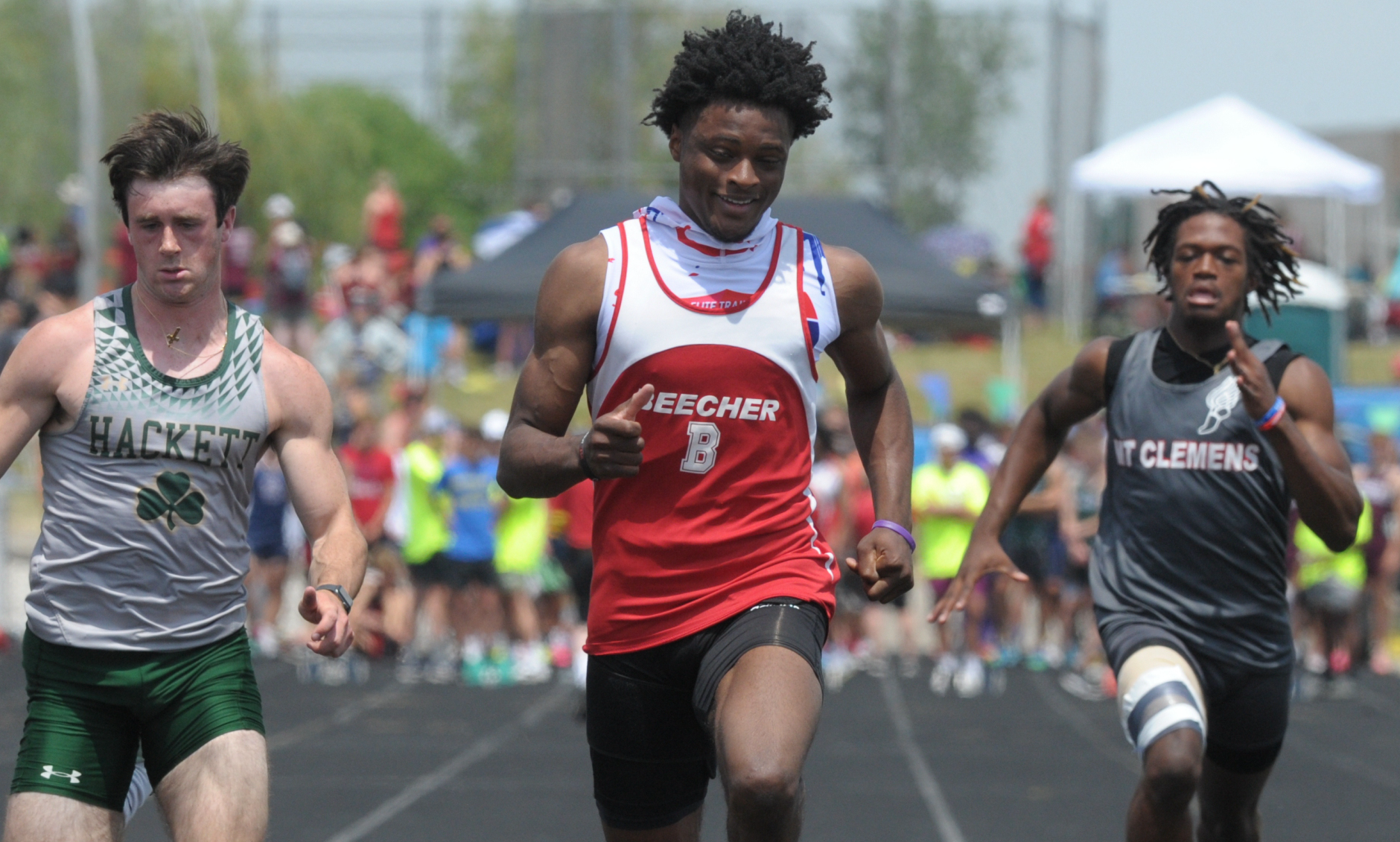 “Perseverance; I said from the beginning what I was going to do. I kept my eye on that target, and no matter the circumstances life threw at me, that I was going to make it happen and I am a man of my word.”
“Perseverance; I said from the beginning what I was going to do. I kept my eye on that target, and no matter the circumstances life threw at me, that I was going to make it happen and I am a man of my word.”
Jaylin Townsend, a senior from Flint Beecher, dominated the short races. He won the 100 dash (10.67) and 200 dash at 22 seconds flat. It was his third 100 win at a Finals.
“I put in a lot of work; I had to three-peat,” he said after the 100. “There’s a lot of great competition here, so I knew I had to come out and run my best.”
Concord in the 400 (43.72), Buckley in the 800 (1:30.76) and 1,600 (3:29.13) and Potter’s House in the 3,200 (8:14.18) were relay champs Saturday. Reading’s Tayshawn Bester won the 110 hurdles (15.13), and Athens’ Landen Bennett won the 300 (39.85). Caseville’s Nathan Feltner won the 400 (50.76), and Vestaburg’s Owen Patton claimed the 800 (1:55.11).
Fruitport Calvary Christian’s Bradley Richards won the high jump (6-10), and Peck’s Alex Affer won the long jump (23-4). McBain Northern Michigan Christian’s Isaac Bowden was first in pole vault (13-0), and Brown City’s Kyle Affer won shot put (49-2).
PHOTOS (Top) Kalamazoo Hackett Catholic Prep celebrates its third-straight LPD4 title Saturday. (Middle) Cardinal Mooney's Tyler Lenn, far right, sets the pace in the 1,600. (Below) Flint Beecher's Jaylin Townsend, middle, crosses the finish first for one of his two sprint championships. (Photos by Ken Swart/RunMichigan.com.)

